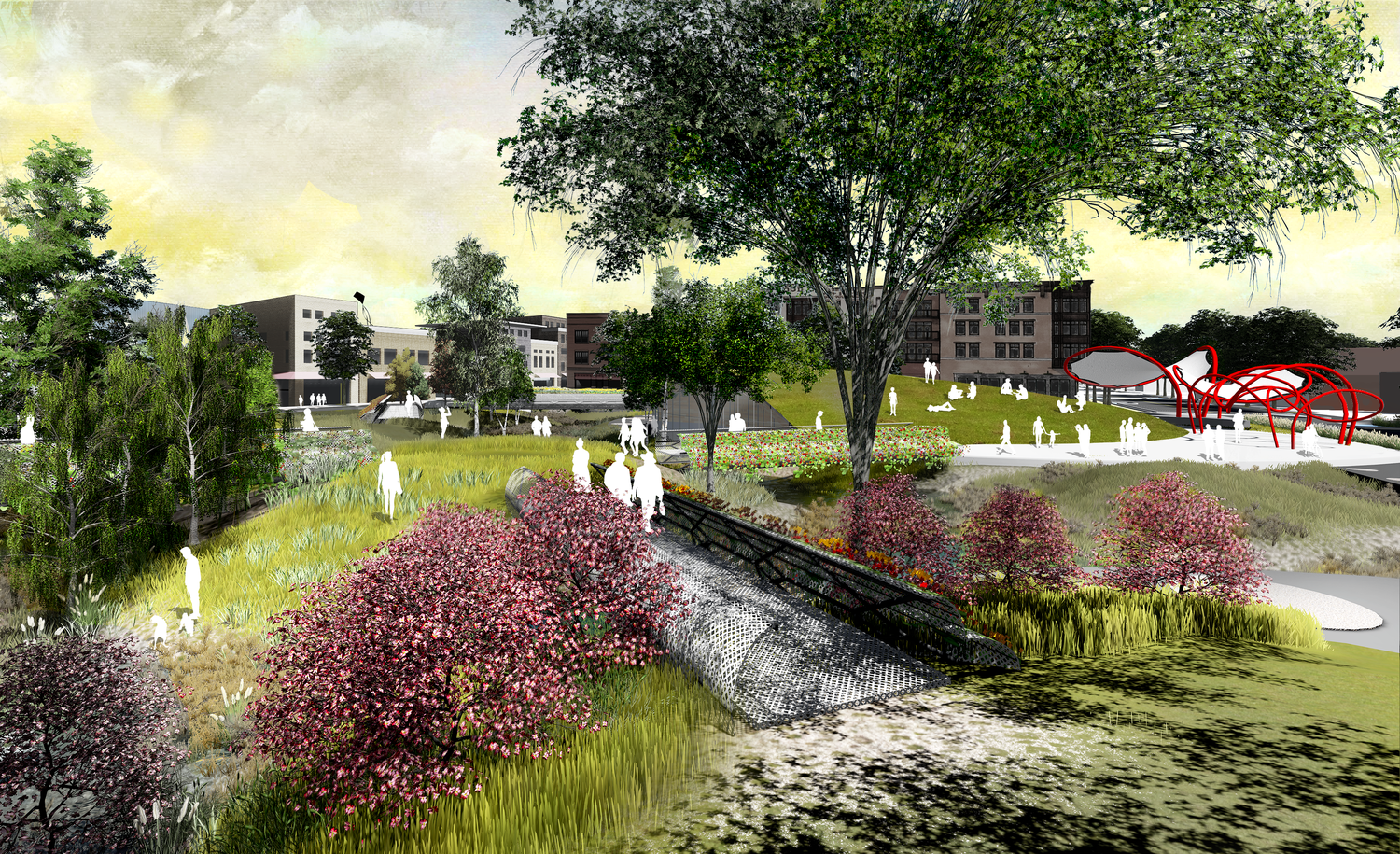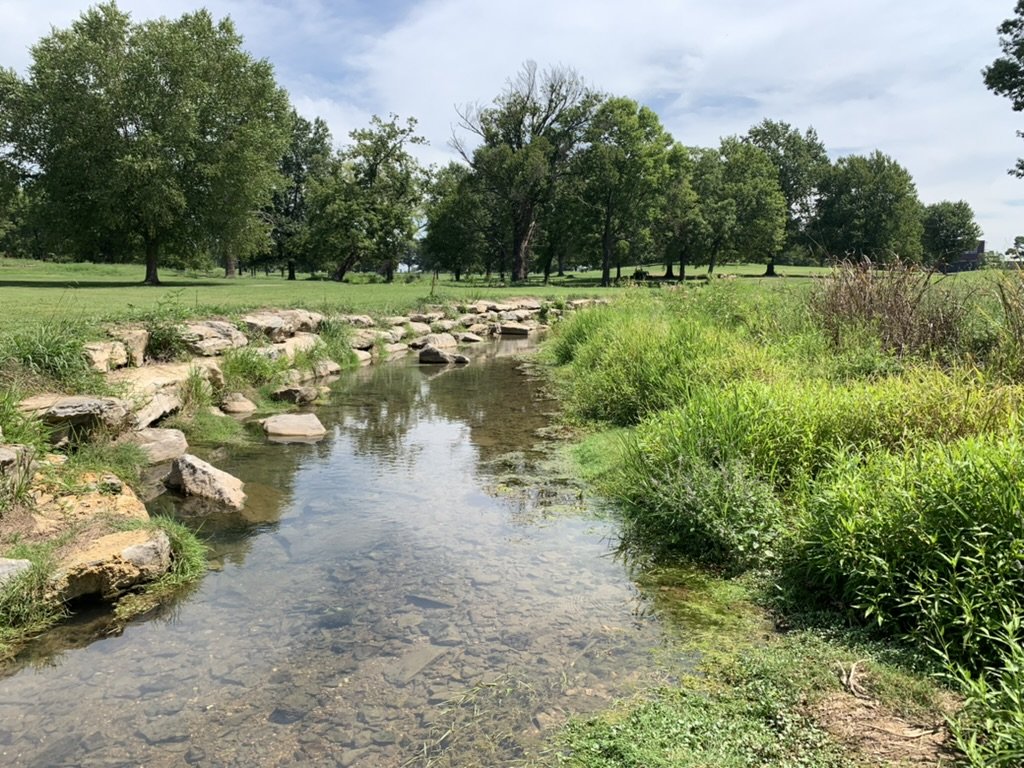
Commercial LID
Expand your knowledge of LID (Low Impact Development) practices for commercial and urban development.
PHOTO: UACDC
Adopt the Watershed Approach to development.
The three tenets of the watershed approach:
Enhance landscape biodiversity
Maximize water infiltration and eliminate runoff
Engineer hydrology in distributed networks
“Reform is difficult because everyone’s models and business plans were formulated around the prevailing, hard-engineering model. This model creates cognitive barriers for LID implementation, including a lack of local precedent, a perception of risk, and a learning curve for the construction industry.”
Green Infrastructure Cost Share Program at IRWP
The Green Infrastructure Program is a cost-share program. IRWP can fund up to 50% of all project costs. Landowners can generate match through in-kind labor, equipment, cash, or other grant dollars. Learn More
Detention pond retrofits
Bioswales
Permeable pavement and ribbon driveways
Green roofs
Green streets
Rain gardens
When it rains, stormwater runs over impervious hard surfaces picking up pollutants such as yard debris, trash, fertilizers, vehicle fluids, and pet waste, which are washed into storm drains that connect to our local waterways.
LID and Green Infrastructure can help by soaking in stormwater and phytoremediating pollutants.
Recommended Practices, A Summary
Go from thinking about stormwater needing “facilities” vs stormwater needing “networks” of catchment and treatment. Create better distribution to create resiliency. Connect facilities in multiple routes to reduce the effects of gaps and overload. Hybrid conventional (hard-engineering) and ecological systems (soft engineering) built in a network are the key.
Upgrade surface materials. Maximize parking lots, roads, and sidewalks by utilizing more green bands, edges, pixels, and “parking gardens”. Pixelated parking reduces impervious surface area by pixelating the parking surface with LID paving and landscaping which regulates the climate, the atmosphere, reduces erosion, and increases filtration, infiltration, sediment retention, and flow attenuation. “Parking gardens” are attractive and an effective means of treating stormwater. Some facilities are:
Porous asphalt
Pervious concrete
Interlocking paver systems
Alternative paving systems
Gravel systems
Grass, concrete, and turf pavers
Integrate components of low-impact streets. Consider curb alternatives that include features like curb cuts, flush curbs, LID curb extensions, and integrated plants via bioswales and rain gardens to replace pipe and pond facilities. These alternatives convert point source flow to sheet flow and provide sediment capture. These should also be designed with urban trees in mind. More examples of alternative designs are eco-boulevards and the utilization of arterial streets and parkways vs. local streets.
Urban green spaces can serve recreational, aesthetic, and comprehensive ecological purposes. Open space should be comprehensively planned as a green network that maintains waterbody functioning and ecosystem connectivity through the use of designed parks, greenways, and self-organizing conservation areas. Consider treatment parks, water harvesting parks, and maximizing greenways.
Encourage conservation development. Every effort should be made to eliminate development in the floodplain and maintain a 100’ riparian (vegetated) buffer along stream edges, as well as to protect wetland features, prairie mounds, or other landmarks of cultural/historical/ecological interest.
“Compact residential development conserves 30-80 percent of a site’s buildable land as permanent, undivided open space. While lots in conventional neighborhoods may be large, their natural landscapes are usually replaced by industrial lawns that diminish ecological functioning. Despite their low densities, sprawling subdivisions ruin viewsheds that initially attracted property investors to the site. Conservation design allows for the same number of homes as a conventional development, with greater savings in infrastructure costs due to shorter street lengths. Increased density and shared open space, as numerous studies have shown, also offer spacial unity and ecological integrity while creating premium market value.”
— Low Impact Development: A Design Manual pg 130

Oversize pipes
Flow control devices
Flow splitter
Level spreader and rock swale
Permeable weir
Curbs
Check dams
Tree mound
Splash block and rip-rap
Dry swales and bioswales
Underground detention
Vegetated detention
Wet vaults
Rainwater harvesting
Rain barrels
Slim tanks
Plastic, fiberglass, metal, or wood cisterns
Pre-cast septic tank
Bladder tank
Filter strips
Underground sand filter
Surface sand filter
Vegetated walls
Vegetated roofs
Infiltration trenches and basins
Tree box filter
Other LID Facilities that should be integrated in combination to create treatment networks
Contact us about Commercial Low Impact Development.
contact@irwp.org
(479) 203-7084
221 S Main St. / P.O. Box 205
Cave Springs, AR 72718
Overview of Commercial Low Impact Development
Low Impact Development (LID) Stormwater Doesn't have to be a Headache
Green Solutions to Stormwater Runoff
Green Stormwater Infrastructure / Low-Impact Development Toolbox of Solutions
Permeable Surfaces
Impermeable surfaces such as asphalt of parking lots and concrete sidewalks create runoff, which picks up pollutants and pours into our stormwater drainage systems. By reducing the amount of impermeable surfaces in our cities, we reduce the amount of polluted runoff that enters our rivers. You will find that permeable solutions are cost-effective and can even increase the longevity of those areas.
Rain Gardens and Bioswales
Rain gardens and bioswales are vegetated areas created to catch stormwater runoff. By allowing the runoff to soak into the ground rather than running into the drainage system, more pollutants are filtered out. Rain gardens and bioswales are attractive additions that promote plant, insect, and wildlife habitation.
Low Impact Development - Rain Gardens
Low Impact Development - Bioswales
Using Native Plants to Improve Stormwater Quality in Urban and Suburban Landscapes
Green Roofs
Vegetated roofs are also called "green roofs". These are designed to-- you guessed it, soak up rainwater! Working as a great insulator, a green roof is a great option for commercial buildings and residences alike. Green roofs are also used to grow food in urban areas.
Green Infrastructure & Low Impact Development
Read more here
Green infrastructure supports sustainable communities. Low Impact Development (LID) is an approach to land development (or re-development) that works with nature to manage stormwater as close to its source as possible. LID employs principles such as preserving and recreating natural landscape features, minimizing effective imperviousness to create functional and appealing site drainage that treat stormwater as a resource rather than a waste product.
Ozark Native Plants and Trees
Plant natives! Read why here: The Perfect Lawn (IRWP Stewardship Story)
NATIVE PLANT LISTS
Helpful lists for gardeners and landscapers in NW Arkansas, created by Wild Ones Ozark Chapter
Well Behaved Natives – Lissa Morrison
Native Plants for Shade – Lissa Morrison
Native Plants that Colonize — Lissa Morrison
Native Plants for Dry, Shallow, Rocky Soil – Lissa Morrison
Ornamental Native Grasses for Landscape Design — Lissa Morrison
Lists from other organizations
Top Butterfly & Moth Host Plants for Northwest Arkansas — National Wildlife Federation
Top Host Plants for Butterflies and Moths – Prairie Nursery
Riparian Tree and Shrub List – Beaver Watershed Alliance
Deer Resistant Native Plants – Shaw Nature Preserve
Deer Resistant Native Plants – Missouri Botanical Garden
Audubon Native Plants Database (with information on bird species attracted to each native plant listed)
Ozark Native Plants for Phytoremediation— Eric Fuselier
Ozark Native Plant Species for Phytotoremediation of Air Pollutants
Ozark Native Plant Species for Phytotoremediation of Petroleum
Ozark Native Plant Species for Phytotoremediation of Pesticides
Ozark Native Plant Species for Phytotoremediation of Chlorinated Solvents
Ozark Native Plant Species for Phytotoremediation of Heavy Metals
“HOW TO” RESOURCES
Rain Garden Fact Sheet – Beaver Watershed Alliance
Rain Garden Information – University of Arkansas Extension
Wildflower Site Preparation – Prairie Moon Nursery
How to Grow a Prairie from Seed – Prairie Moon Nursery
INFORMATION ON INVASIVE PLANT SPECIES
Commercially Available Invasive Plants in NW Arkansas – Arkansas Native Plant Society
Invasive Plant Species Found in Arkansas – Arkansas Natural Heritage Commission
Demonstration on Removing Bush Honeysuckle – Colin Massey from the University of Arkansas Agricultural Extension Office
ONLINE RESOURCES TO HELP WITH PLANT SELECTION
ONLINE RESOURCES FOR NATIVE PLANT INFORMATION
HORTICULTURAL PROFESSIONALS IN NORTHWEST ARKANSAS
Horticulture Professionals NWA (Provided by Ozark Wild Ones, uploaded May 2023)
Missed our 2021 NWA LID Conference?
No worries, you can find the presentations from the conference, educational documents, and other Northwest Arkansas LID information at irwp.org/nwalid2021.










